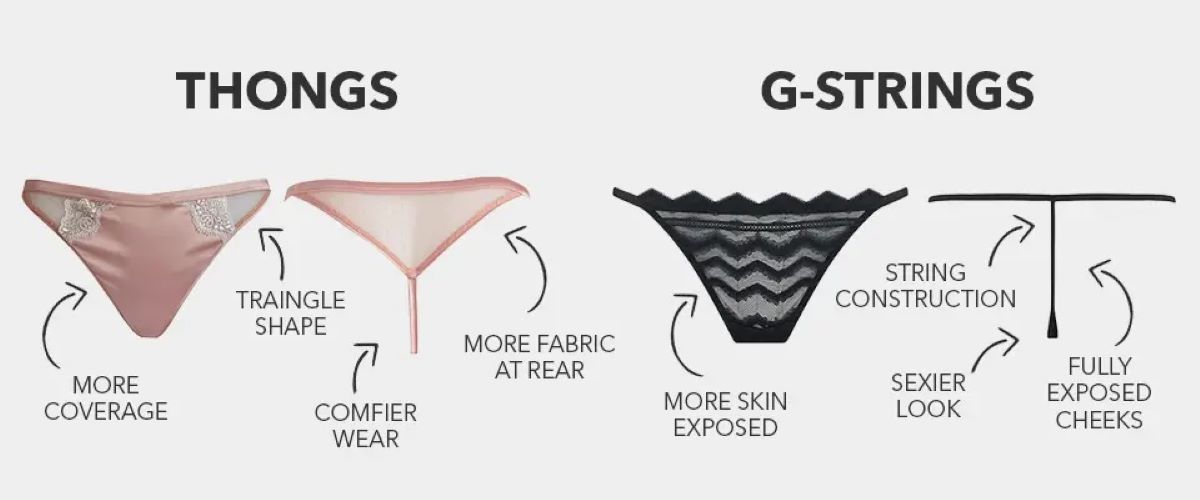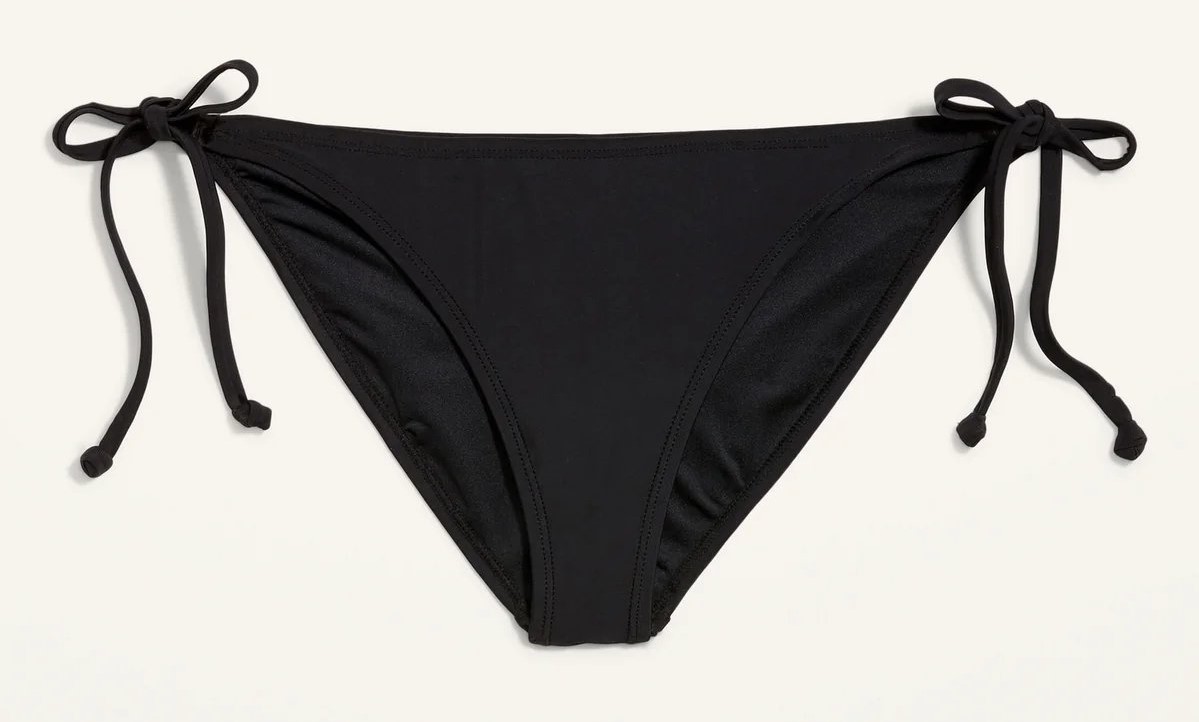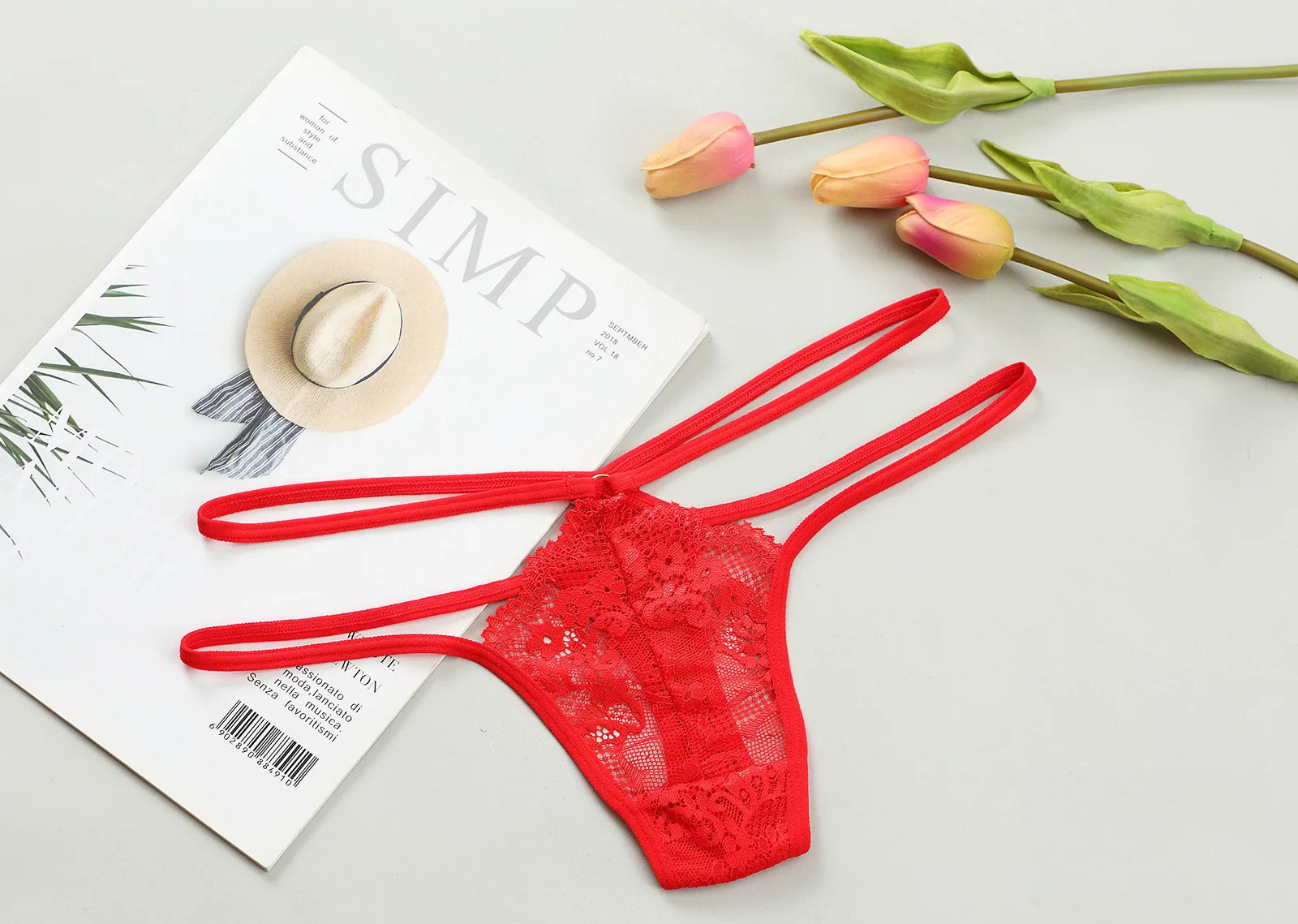Home>Women's Underwear>Thongs>What’s The Difference Between A Thong And A G String


Thongs
What’s The Difference Between A Thong And A G String
Modified: September 23, 2023
Discover the key distinctions between a thong and a G-string in this informative article. Explore their designs, coverage, and the level of comfort they offer.
(Many of the links in this article redirect to a specific reviewed product. Your purchase of these products through affiliate links helps to generate commission for Under-tec.com, at no extra cost. Learn more)
Table of Contents
Introduction
When it comes to lingerie, there are various styles and types available to suit different tastes and preferences. Two popular options that often confuse people are thongs and G-strings. These provocative undergarments are often associated with sensuality and can make a bold statement. However, many people are not aware of the differences between a thong and a G-string.
In this article, we will delve into the nuances of these two lingerie styles and explore their characteristics, similarities, and differences. By the end, you’ll have a clear understanding of what sets a thong apart from a G-string, and perhaps gain insights into which style may appeal to you.
While both thongs and G-strings are designed to minimize visible panty lines and offer minimal coverage, there are distinct features that differentiate them. From their design and coverage to their level of comfort and style, each has its unique attributes.
So, if you’ve ever wondered about the difference between a thong and a G-string, or if you’re simply curious about lingerie fashion, keep reading as we explore these intriguing undergarments.
Definition of a Thong
A thong is a style of underwear that is known for its minimal coverage. It typically consists of a narrow strip of fabric, usually in the shape of a ‘T’ or a ‘Y’, that connects the front and back of the garment. The thin strap of fabric rests between the buttocks, providing minimal coverage to the rear while leaving the hips and lower abdomen exposed.
Thongs come in various designs and materials, from cotton and lace to satin and mesh. They are available in a range of colors and patterns, catering to different style preferences. The waistband of a thong can vary in width, with some featuring a thin elastic strap and others showcasing a wider band for added comfort and support.
Thongs are designed to be discreet under tight-fitting clothing, with the minimal fabric reducing visible panty lines. They are also favored by individuals who wish to embrace their sensuality and feel empowered. Thongs can boost confidence and make the wearer feel more feminine and seductive.
Although thongs are often associated with women, there are also styles available for men. Men’s thongs offer similar minimal coverage, with a thin pouch in the front and a thin strip of fabric at the back. They provide both support and a revealing look.
It’s important to note that while thongs offer minimal coverage, they still serve the purpose of providing a barrier between the body and outer clothing. They are not intended to be worn as a replacement for regular underwear, but rather as a specific style choice for certain occasions or personal preference.
Definition of a G-String
A G-string is a style of lingerie that is even more revealing than a thong. It is designed to provide the least amount of coverage possible while still maintaining some level of modesty. The distinguishing feature of a G-string is its thin string-like waistband that rests low on the hips, connecting to a small triangular fabric patch at the front and a thin strip at the back, which goes between the buttocks.
G-strings are often made from delicate materials such as lace, satin, or silk, which adds a touch of glamour and elegance to their seductive style. The triangular fabric patch at the front serves the purpose of covering the pubic region, while the thin strip at the back leaves the buttocks almost entirely exposed.
These ultra-revealing undergarments are commonly worn for special occasions or intimate moments, adding an element of allure and excitement to the atmosphere. They are favored by individuals who want to embrace their sensuality and make a bold statement with their choice of lingerie.
It’s worth noting that G-strings are available for both men and women. Men’s G-strings generally feature a small triangular fabric patch at the front, similar to women’s G-strings, and a thin string-like waistband and back, providing a tantalizing look. They are commonly worn as a provocative underwear choice or for boudoir photography.
Due to their minimal coverage, G-strings are often associated with exotic dancers and the world of adult entertainment. However, they are also popular among individuals who simply enjoy the freedom and confidence that comes with wearing such daring lingerie. It is important to remember that G-strings are a personal choice and can be worn by anyone who desires to express their individuality and embrace their body.
Key Similarities
While thongs and G-strings have their unique characteristics, there are several key similarities between these two styles of lingerie:
- Minimal Coverage: Both thongs and G-strings offer minimal coverage compared to traditional underwear styles. They are designed to reduce visible panty lines and provide a more discreet look under tight-fitting clothing.
- No Rear Coverage: Both styles feature a narrow strip of fabric that rests between the buttocks, leaving the rear almost entirely exposed. This design element enhances the overall sexy and revealing look of these undergarments.
- Sensual Appeal: Both thongs and G-strings are associated with sensuality and can make the wearer feel more attractive and confident. They are often chosen for special occasions or to add a touch of excitement to intimate moments.
- Variety of Materials: Thongs and G-strings are available in a wide range of materials, including lace, satin, silk, and mesh. This allows individuals to choose a style that aligns with their personal preferences and comfort.
- Men’s Options: Thongs and G-strings are not limited to women’s lingerie alone. Both styles have variations specifically designed for men, offering them the option to embrace a more daring and provocative look.
These shared features make thongs and G-strings appealing to those who want to enhance their confidence, make a fashion statement, or simply enjoy the liberating feeling of wearing minimalistic and stylish underwear.
Key Differences
While thongs and G-strings have some similarities, there are also distinct differences between these two lingerie styles:
- Design and Coverage: Thongs typically have a wider strip of fabric that provides more coverage in the front and back compared to G-strings. G-strings, on the other hand, feature a thin string-like waistband and a minimal triangular fabric patch at the front, with the back almost entirely bare.
- Comfort and Fit: Thongs generally offer a bit more comfort and support due to the wider waistband and wider coverage. G-strings, with their minimalistic design, may feel more revealing and require a certain level of comfort with less fabric coverage.
- Style and Fashion: Thongs are often seen as a more mainstream and versatile option, suitable for everyday wear, while G-strings are associated with more intimate or provocative occasions. Thongs can come in various designs and styles, including high-waisted thongs, while G-strings tend to maintain a consistent, revealing look.
- Common Uses: Thongs are commonly worn as an everyday underwear choice, whereas G-strings are often reserved for special occasions, intimate moments, or for those who wish to make a bold and daring fashion statement.
- Cultural and Historical Significance: Thongs have been a part of various cultures for centuries, with historical evidence of thong-like garments dating back to ancient times. G-strings, in comparison, gained popularity in more modern times and became associated with certain subcultures and industries.
These differences in design, comfort, versatility, and cultural significance give individuals the opportunity to choose the option that best suits their personal preferences, style, and comfort level. Ultimately, whether you prefer the slightly more coverage of a thong or the daring and minimalistic look of a G-string, both styles offer their own unique appeal and can empower the wearer in different ways.
Design and Coverage
The design and coverage of thongs and G-strings are two distinct factors that set them apart from each other.
Thongs typically have a wider strip of fabric that provides more coverage in both the front and back compared to G-strings. The front of a thong often features a wider triangular fabric panel that covers more of the pubic region. The back of a thong also has a wider strip of fabric, which rests between the buttocks.
G-strings, on the other hand, take minimal coverage to the extreme. They have a thin string-like waistband that rests low on the hips and a small triangular fabric patch at the front, which covers the pubic region. The main distinguishing feature of a G-string is the thin strip of fabric that runs between the buttocks, leaving very little to the imagination. This minimalistic design offers the least amount of coverage possible while still maintaining some level of modesty.
When it comes to design and variety, thongs tend to offer more options. They can come in various styles such as high-waisted thongs, low-rise thongs, or even seamless thongs. Thongs can be found in a wide range of materials, including cotton, lace, satin, and mesh. The waistband of a thong can vary in width, from a thin elastic strap to a wider band for added comfort and support. This versatility in design allows individuals to find a thong that matches their personal style and preference.
G-strings, on the other hand, typically maintain a consistent design. They focus on the minimalistic aesthetic, with a thin string-like waistband and a small triangular fabric patch at the front. The lack of variation in the design of G-strings is what helps them achieve their ultra-revealing and provocative look.
Ultimately, the design and coverage of thongs and G-strings provide individuals with options that cater to different comfort levels and style preferences. Whether you prefer the slightly more coverage of a thong or the daring and minimalistic look of a G-string, both styles offer unique designs that can add a touch of sensuality and excitement to your lingerie collection.
Comfort and Fit
When it comes to comfort and fit, there are notable differences between thongs and G-strings.
Thongs generally offer a bit more comfort and support due to their wider waistband and wider coverage in both the front and back. The wider waistband helps distribute the pressure more evenly and prevents any potential discomfort caused by a thin string-like waistband. The wider coverage also offers a sense of security and may be preferred by individuals who prefer a slightly more modest option.
G-strings, on the other hand, prioritize minimalistic design over comfort. The thin string-like waistband and minimal fabric coverage in the front and back can take some time to get used to. The lack of fabric can feel more revealing and require a certain level of comfort with less coverage. However, for those who embrace the daring nature of G-strings, the feeling of freedom and sensuality they provide can outweigh any initial discomfort.
Comfort and fit also depend on personal preferences and body types. Thongs are available in various styles, including low-rise and high-waisted options, which allows individuals to choose the fit that feels most comfortable for them. G-strings, on the other hand, have a more standardized fit due to their minimalistic design, although some variations provide adjustable waistbands to accommodate different body sizes.
It’s important to consider the materials used in the construction of thongs and G-strings as they can greatly impact comfort and fit. Soft and stretchy fabrics, such as cotton blends or microfiber, can enhance comfort and provide a better fit compared to stiffer materials. Additionally, the quality of craftsmanship, including the stitching and construction of the underwear, can also affect overall comfort and fit.
In the end, comfort and fit are subjective and can vary from person to person. It’s essential to try on different styles and materials to find the thongs or G-strings that not only provide the desired look but also offer comfort and a flattering fit for your individual body shape.
Style and Fashion
Thongs and G-strings both make a bold fashion statement and are associated with sensuality and confidence.
Thongs are often seen as a more mainstream and versatile option when it comes to lingerie. They come in various designs, styles, and fabrics, catering to different tastes and preferences. From lacy and feminine to sporty and seamless, there is a wide range of options to choose from. Thongs can be worn on a daily basis as everyday underwear, as they offer minimal coverage and reduce visible panty lines under tight-fitting clothing. Thongs can also be paired with matching bras to create a coordinated lingerie set for a complete and fashionable look.
G-strings, on the other hand, are often reserved for special occasions or intimate moments due to their daring and revealing nature. They are perceived as more provocative and seductive, making them an ideal choice for those looking to enhance their sensuality and make a bold statement. G-strings are commonly found in delicate materials such as lace, satin, or silk, adding an element of luxury and glamour to their style. They are often chosen for boudoir shoots or to create a sexy and alluring look for intimate encounters.
When it comes to overall style, thongs can offer more versatility as they can be seamlessly integrated into various outfits and styles. They can be worn under jeans, skirts, and dresses, ensuring a smooth and discreet look. Thongs are also popular among individuals who want to feel confident and feminine throughout the day. On the other hand, G-strings are more suited for specific occasions where the emphasis is on creating a daring and bold statement. They are designed to be shown off and can be a key element in enhancing a lingerie or roleplay outfit.
Both thongs and G-strings are known for their empowering nature, allowing individuals to embrace their sensuality and feel more confident in their bodies. Whether it’s for personal enjoyment or to surprise a partner, the style and fashion of these lingerie pieces offer an opportunity to express oneself and explore different aspects of their sexuality.
Common Uses
Thongs and G-strings serve different purposes and are commonly worn for various occasions.
Thongs are often chosen as an everyday underwear option due to their versatility and ability to minimize visible panty lines. They provide a seamless look under tight-fitting clothes, making them a popular choice for workwear, casual outfits, or any occasion where one desires a discreet undergarment that offers minimal coverage. Thongs are also commonly used for physical activities like workouts or sports, as they provide freedom of movement and reduce friction.
G-strings, on the other hand, are typically reserved for special occasions or intimate moments. They are often chosen for romantic encounters, as they create a seductive and provocative look that can enhance intimacy and boost confidence. G-strings are commonly worn for boudoir photography, exotic dancing, or to surprise a partner with an alluring and daring lingerie choice. Some individuals may also wear G-strings as a form of self-expression or to feel empowered in their own body.
Both thongs and G-strings are popular choices for individuals who want to embrace their sensuality and make a statement with their choice of lingerie. They can be seen as empowering garments that allow individuals to feel confident and sexy in their own skin.
It’s important to note that personal preference plays a significant role in determining the common uses of thongs and G-strings. Some individuals may choose to wear thongs for special occasions, while others may feel more comfortable and empowered in G-strings as their everyday lingerie choice. Ultimately, the common uses of these undergarments can vary depending on individual style preferences, body confidence, and personal comfort levels.
Cultural and Historical Significance
Thongs and G-strings have cultural and historical significance that has evolved over time.
Thongs, or thong-like garments, have been a part of various cultures throughout history. In ancient times, both men and women in civilizations such as Egypt, Rome, and Greece wore loincloths or similar minimalistic undergarments. These early iterations of thongs served practical purposes, such as providing necessary coverage while allowing for ease of movement in hot climates. In some cultures, thongs were also worn as a symbol of status or as part of traditional attire.
G-strings, however, gained popularity in more modern times. The term “G-string” is believed to derive from the garments worn by dancers in the cabarets of the early 20th century, where the “G” referred to the use of a thin string as the primary waistband. Over time, G-strings became more associated with the world of exotic dancing and adult entertainment.
Today, thongs and G-strings have become widely accepted as fashionable lingerie choices and are often associated with sexuality, confidence, and sensuality. They have integrated into mainstream fashion and are commonly worn by individuals of various cultural backgrounds as an expression of personal style and taste.
In some cultures, thongs and G-strings may still hold traditional or symbolic significance. For example, in certain tribal communities, minimalistic undergarments that resemble thongs are worn as part of traditional ceremonial attire or as a representation of cultural heritage.
It’s important to recognize and respect the cultural diversity and historical contexts surrounding these garments. While thongs and G-strings may have become synonymous with fashion and sensuality in modern society, their roots trace back to ancient traditions and cultural practices that have evolved over time.
Conclusion
Understanding the differences between thongs and G-strings can help individuals make informed choices when it comes to their lingerie preferences. Thongs offer a slightly more coverage while still providing a sleek and discreet look under clothing. They are versatile enough to be worn in everyday situations and can boost confidence and comfort. On the other hand, G-strings take minimalistic coverage to the extreme, catering to those who desire an ultra-revealing and provocative style. They are often reserved for special occasions or intimate moments, allowing individuals to embrace their sensuality and make a bold fashion statement.
Both thongs and G-strings have their place in the world of fashion and self-expression. It’s important to note that personal preference, comfort, and body confidence play significant roles in choosing between these styles. Whether you opt for the wider coverage and versatility of a thong or the daring and minimalistic allure of a G-string, both styles offer unique features that can empower and enhance your personal style.
Regardless of which style you choose, it’s essential to prioritize comfort and fit. Trying on different designs, materials, and sizes can help you find the perfect thong or G-string that not only makes you feel confident but also provides a flattering fit for your individual body shape. Remember that lingerie is a celebration of your uniqueness and sensuality, so embrace the style that makes you feel your best.










